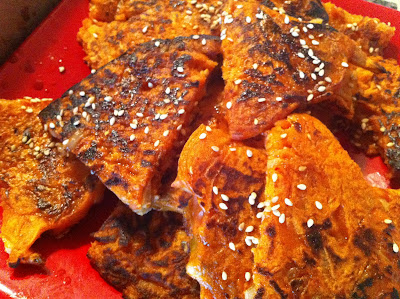Since moving to DC, most of my cooking has fallen into two camps: recipe testing for the newsletters I'm continuing to write for The Cooking Club and lots of Korean food.
Jake made some baked tofu recently with a sweet and spicy gochuchang-based sauce. We used the leftover to make a tteok fondue of sorts. I had these extra long rice cakes in the freezer and I made them the Momofuku way for dipping in the red sauce.
The rice cakes went into a very hot cast iron grill pan with vegetable oil until they started smoking. Once they were browned on all sides, I brushed them with sesame oil and took them off the heat. I served them with grilled odeng (the fish cake) and dipped them in the warmed gochuchang sauce.
The gochuchang sauce includes brown sugar, grated ginger, minced garlic, soy sauce, sesame oil and gochuchang. It's a bit stronger and sweeter in flavor, I think, that your typical tteokbogi sauce.
There comes a point in every jar of kimchi when you take a sniff and there's only one word to describe your result: funky. It's that point where the sharp, pungent taste of kimchi has ripened a bit over the edge. It's not that you can't eat the kimchi any more, it's just not as delicious as when you first break open a brand new jar.
Thankfully, there are plenty of options for extra ripe, funky kimchi. One option, great for the fall and winter months is to make a steaming, bubbling pot of kimchi chiggae. Better for the summer months, I'm a fan of kimchi pajeon (above).
I also had some homemade Korean radish pickles in the fridge that had also gotten a little funky, so I chopped it up with the kimchi and mixed them into the pancakes. It's always hard to get these crispy enough (as soon as you put them on a plate, the steam trapped between the hot pancake and the plate condenses), but they are fabulous dipped in soy sauce and sprinkled with toasted sesame seeds.
Korean snacks have definitely been one of the highlights of moving back to DC this summer. Enjoy!



No comments:
Post a Comment